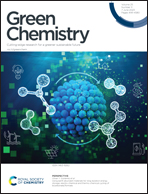Long-term stable and catalytic 2D MXene nanosheets wrapped with dialdehyde xylan for ultrafast gelation†
Abstract
Developing aqueous stable and catalytic Ti3C2Tx MXene suspensions remains a grand challenge. MXene nanosheets always undergo rapid degradation when exposed to water and oxygen, and the incorporation of reducing or capping agents may deteriorate the intrinsic characteristics of MXenes. Here, we coupled dialdehyde xylan (DAX) with MXene nanosheets to significantly increase the long-term storage of MXene in an aqueous solution (>3 months) with a dramatic enhancement of their room temperature catalytic activity for ultrafast gelation. DAX can form thick and smooth layers on the nanosheets via multiple hydrogen bonds, providing a reduction environment to prevent the occurrence of oxidation. Meanwhile, DAX can accelerate the generation of free radicals from the potassium persulfate (KPS)/MXene pair, reducing the polymerization time of vinyl monomers from ∼30 min to ∼90 s. Moreover, the DAX layer is capable of serving as additional crosslinks by leveraging Schiff base bonds with chitosan (CS), with the elongation at break increasing from 100% to 909%. The resultant MXene-based hydrogel can be further explored as a sustainable sensor for real-time physical signal monitoring. This work offers an enticing prospect for the development of eco-friendly and high-performance MXene-based materials.



 Please wait while we load your content...
Please wait while we load your content...